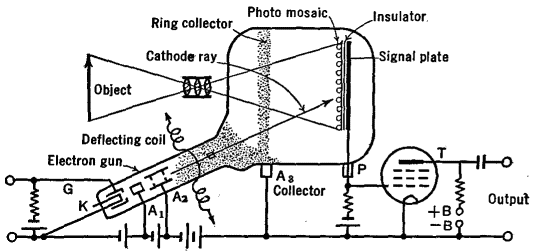| Basic Radio is a free introductory textbook on electronics based on tubes. See the editorial for more information.... |

|

Home  Electronic Devices Electronic Devices  Cathode-Ray Tubes Cathode-Ray Tubes  The Iconoscope The Iconoscope |
||||
| See also: Picture Tubes | ||||






|
||||
|
The IconoscopeAuthor: J.B. Hoag In television there is need for a device which will convert impulses of light into equivalent fluctuating electrical currents, just as the microphone is used to generate electrical currents which are proportional to the sound waves which reach it for the cases of broadcasting and public address systems. One type of television pickup tube is called the iconoscope. Icon means "image" and scope means "to see" (tele-scope, a long distance "see-er"; micro-scope, a small object "see-er "). Figure 21 M shows a modern iconoscope and its associated circuits.
The photo-mosaic consists of a large number of tiny photo-sensitive globules in a single layer, supported on a thin insulating surface (mica) and insulated one from the other. One method of forming the mosaic is, first, to dust silver oxide particles over a mica sheet, then to properly heat the unit so that the oxide is reduced. The silver draws up into tiny droplets, separate from each other. These droplets are sensitized to light during a later stage in the manufacture of the tube, much as an ordinary photoelectric cell is prepared. A metallic coating is deposited on the back of the insulating sheet to form the completed unit.
From the side arm of the iconoscope, an electron gun sends a sharply focused beam of electrons onto the mosaic. By means of deflecting coils, the cathode ray is deflected back and forth across the mosaic in a succession of horizontal lines from top to bottom, scanning the entire surface in 1/30 of a second. As the beam passes over a positively charged droplet, it suddenly replaces the electrons which were lost by photo-emission. The sudden reduction of positive charge on the droplet induces a positive charge on the signal plate (see Fig. 21 M) and hence on the grid of an amplifying tube T. The amount of this positive impulse is proportional to the amount of light which caused photo-electrons to be emitted from the globule during the time between two successive scannings by the cathode-ray beam. The summing-up of the light over this time interval results in more sensitive response to feeble light intensities. As the cathode ray progresses from one part of the mosaic to another, a succession of impulses is delivered to the amplifying tube, proportionate to the amounts of light emitted by the corresponding parts of the object. Thus a complete picture or frame is scanned every 1/30 second. This means that the picture is scanned 30 times every second. The impulses applied to T (Fig. 21 M) are amplified and used to modulate a transmitter, as in the case of the currents from a microphone.
|
||||
Home  Electronic Devices Electronic Devices  Cathode-Ray Tubes Cathode-Ray Tubes  The Iconoscope The Iconoscope |
||||
Last Update: 2010-11-21


